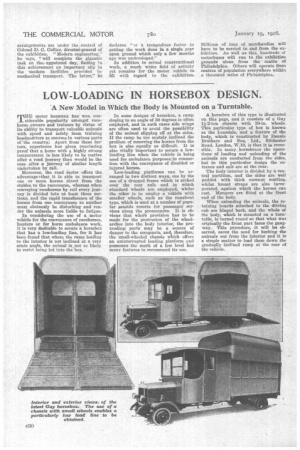LOW-LOADING IN HORSEBOX DESIGN.
Page 14

If you've noticed an error in this article please click here to report it so we can fix it.
'A New Model in Which the Body is Mounted on a Turntable.
MHE motor horsebox has won con
siderable popularity amongst racehorse owners and trainers by virtue of its ability to transport valuable animals with speed and safety from training headqudrters to courses in various parts of 'the country: Apart from these factors, experience has given convincing proof that a horse with a highly strung temperament is less likely to be restive after a road journey than would be the case after a journey of similar length undertaken by rail.
Moreover, the road motor offers the advantage t that it is able to transport one or more horses direct from the stables to the racecourse, whereas when conveying racehorses by rail every journey is divided into at least three sections, and the rapid transference of the horses from one conveyance to another must obviously be disturbing and render the animals more liable to fatigue.
In considering the use of a motor vehicle for the conveyance of racehorses, hunters or for horse ambulance work, it is very desirable to secure a horsebox that has a low-loading line, for it has been found that where the ramp leading to the interior is not inclined at a very acute angle, the animal is not so likely to resist being led into the box. In some designs of horsebox, a ramp sloping to an angle of BO degrees is often employed, and in such cases side wings are often used to avoid the possibility of the animal slipping off at the sides. If the ramp be too acutely inclined the problem of removing the horses from the box is also equally as difficult. It is also vitally important to secure a lowloading line when the vehicle is being used for ambulance purposes'in connection with the conveyance of disabled or injured horses.
Low-loading platforms can be arranged in two distinct ways, one by the use of a dropped frame which is arched over the rear axle and in which standard wheels are employed, whilst the other is to employ a vehicle with smaller wheels, such as the runabout type, which is used at a number of popular easide resorts for passenger services along the promenades. It is obvious that when provision has to be made for the protrusion of the wheelarches into the body interior, the protruding, parts may be a source of danger to the occupants, and, therefore, the small-wheeled chassis which offers an uninterrupted loading platform and possesses the merit of a low level has many features to recommend its use. A horsebox of this type is illustrated on this page, and it consists of a Guy 1i-2-ton chassis with 20-in. wheels. This particular type of box is known as the Lonsdale, and a feature of the body, which is constructed by Dennis Brothers and Son, Ltd., Silchester Road, London, W.10, is that it is reversible. In many horseboxes the operations of loading and unloading of the animals are conducted from the sides, but in this particular design the entrance and exit are at the rear.
The body interior is divided by a central partition, and the aides are well padded with thick coconut matting, whilst breast straps are also ineorporated, against which the horses can rest. Mangers are fitted at the front end of the body.
When unloading the animals, the retaining boards attached to the driving cab are hinged back, and the whole of the body, which is mounted on a tnrntable, is 'turned round so that what was originally the front part faces the gangway. This procedure, it will bs observed, saves the need for backing the animals Out from the interior and it is a simple matter to lead them down the gradually inclined ramp at the rear of the vehicle.






























